- You are here:
- Home »
- Mike Smith
Tag Archives for " Mike Smith "
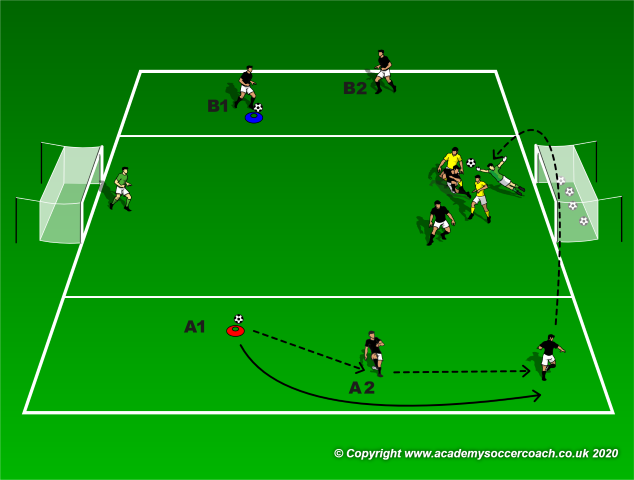
Training for Defending Crosses
By Philip Cauchi –
Title: Defending crosses.
Aim: To develop the communication between the goalkeeper and the two central defenders when dealing with crosses.
Key points:
1. Ready stance in goal.
2. Distance between the goalkeeper and the two central defenders.
3. The goalkeeper needs to communicate continuously with the team and especially the central defenders to keep the shape and mark potential target players from the cross.
Game situation: GK+4 v GK+4 + 2 neutral flank players.
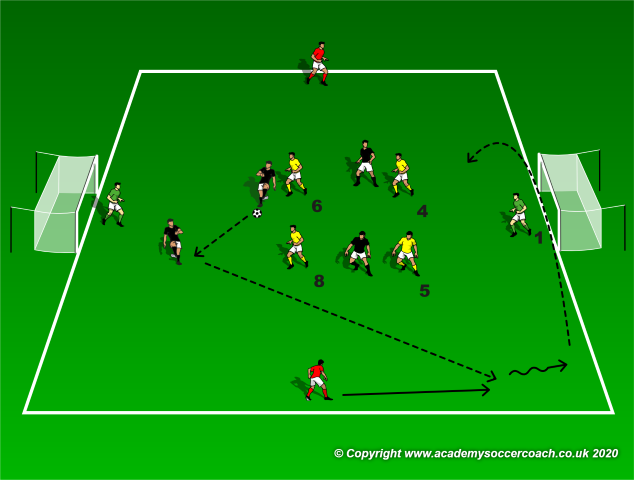
Preparation: The area should measure 40 yards in length and 50 yards in width. Two goalposts are positioned 40 yards apart on each goal line and facing each other. The two teams play in a 1-2-2 formation. A neutral player is positioned on each flank to act as wingers.
Execution: Normal game with positional reference. Goals that come from crosses count twice. All restarts take place from the goalkeeper of the team in possession.
Progression: The neutral flank players may dribble towards the inside and take shots on goal. The crosses may also be played by a player who overlaps the flank player.
Dealing with crosses functional practice: 2v2+GK defend the cross.

Preparation: The same area as in the game is used. However two flank channels each ten yards in width are marked. On each flank there are two players (A1 and A2 on the right flank and B1 and B2 on the left flank) who are positioned at an angle with each other as shown in the diagram above. In the centre there are two forwards, two central defenders and a goalkeeper. If the defending team (central defenders and goalkeeper) wins the ball they counter on the goal defended by the attacking team.
Execution: The players on the flank combine with each other as shown in the diagram above. A1 passes to A2, overlaps her to receive the ball in space and play a cross to the two forwards to conclude on goal while being pressured by the two central defenders and the goalkeeper.
Progressions:
1. Instead of passing the ball to the overlapping player, the flank players can dribble towards the inside and take a shot or search for combinations with the forwards. Taking the example in the diagram, A2 dribbles diagonally towards the inside instead of playing the ball to the overlapping player A1.
2. Instead of delivering a cross, the overlapping player can play a cut back pass.
By Philip Cauchi

Training Quick Reaction and Shot Stopping
By Philip Cauchi –
Title: Guess who’s going to shoot!
Aim: To develop goalkeeping quick reactions and shot stopping techniques.
Key points:
1. Ready stance with the weight on the balls of the feet.
2. When turning always have your hands in front of the body.
3. Body weight slightly forward with the knees bent.
Preparation: Three servers with a ball each. The goalkeeper in the middle of the goal facing backward.
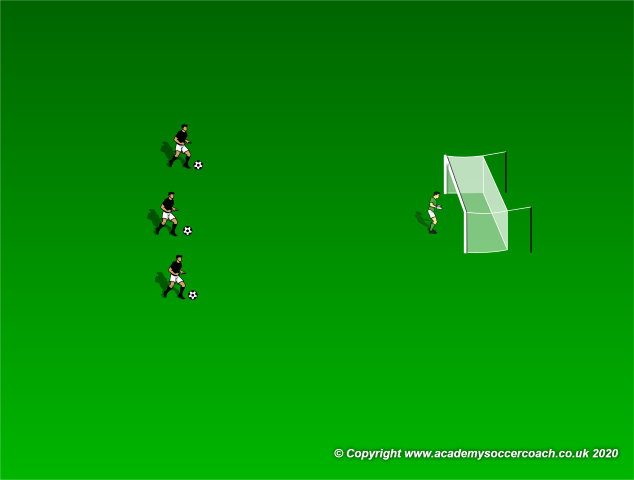
Description: On the coach’s call, the goalkeeper turns and quickly gets into a ready stance to save the shot. The three servers decide among themselves who will kick the ball. The goalkeeper should not know beforehand who the kicker will be.
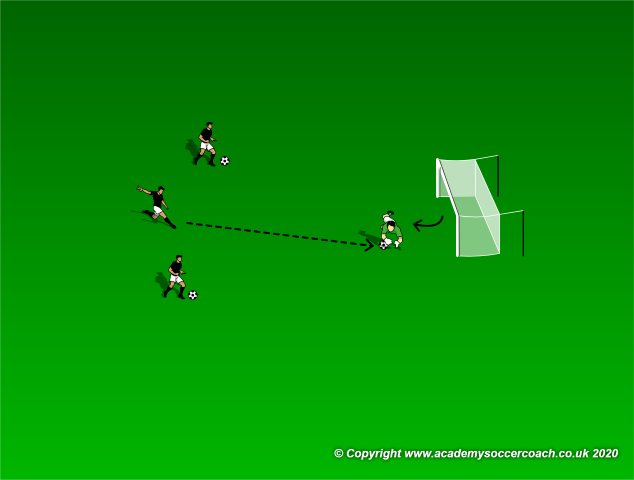
Variations:
1. The kickers pass the ball along the ground instead of kicking the ball hard. This is especially important with younger goalkeepers when working on using the correct technique.
2. The kickers lob the ball for the goalkeeper to practice handling high shots.
3. The kickers always shoot straight at the goalkeeper.
Progressions:
1. Shots may be played both on the ground and in the air.
2. Two shots are taken in sequential order with the second shot to be taken approximately three seconds after the first one. Both the first and the second shots are to remain unknown by the goalkeeper until they are taken.
By Philip Cauchi
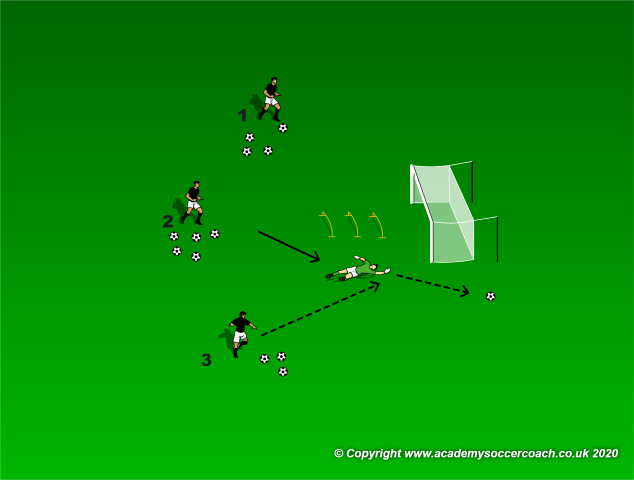
How to Train Quick Reaction Saves
By Philip Cauchi –
Title: Combined plyometric and reaction saves.
Aim: To apply the proper mechanics of saving a shot after landing from a jump.
Key points:
1. After landing, the foot to the side of the dive should be placed diagonally forward towards the side of the dive prior to making the save.
2. When making the save the hands should be placed in the horizontal line in front of the legs.
Practice: Receive the ball to score in the mini goals.
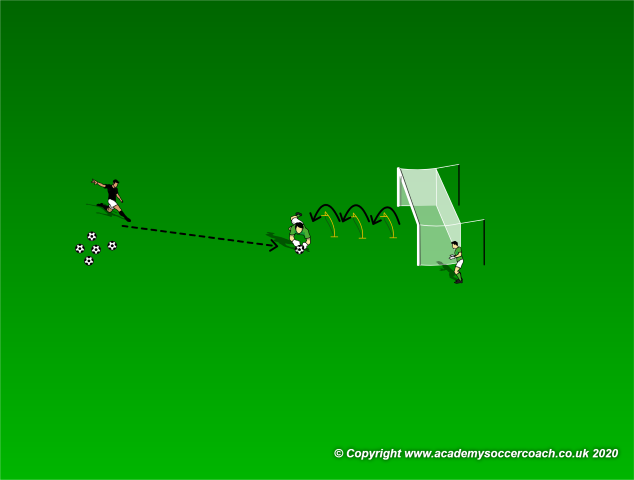
Preparation: Three hurdles in front of the goal. The goalkeeper coach positions herself ten meters in front of the hurdles with a supply of balls.
Description: The goalkeeper makes three consecutive jumps before diving to make the safe from the goalkeeper coach’s shot.
Variations:
1. The goalkeeper jumps laterally prior to making the save.
2. Combine jumping laterally and forward prior to making the save.
3. Differ the height of the hurdles according to the abilities of the goalkeeper.
4. The goalkeeper saves both low and high shots.
Progressions:
1. The goalkeeper saves random shots that can be aimed both low and high.
2. Two or three servers are positioned ten meters in front of the last hurdle. The goalkeeper saves these shots in sequential order.
3. The three servers mentioned in progression two are all positioned at different distances from the final hurdle.
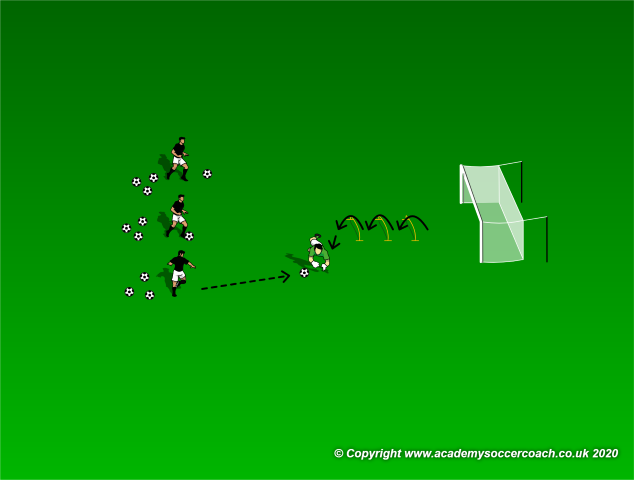
4. Three servers are positioned as indicated in the below diagram. The goalkeeper catches the first shot after making the three consecutive forward jumps.
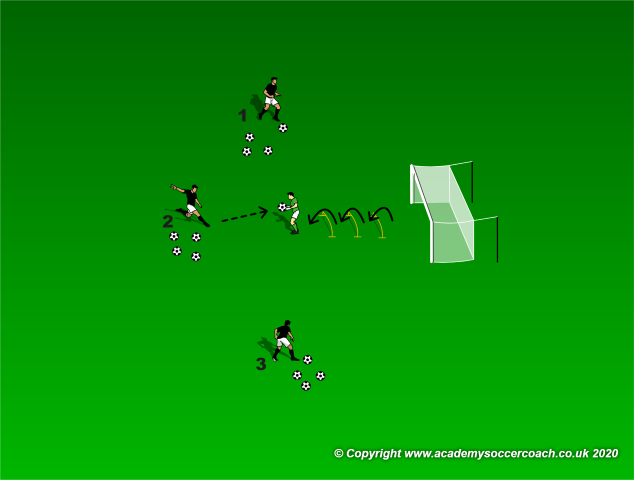
Then moves into position to save the diagonal shot from the server as called by the coach.

By Philip Cauchi
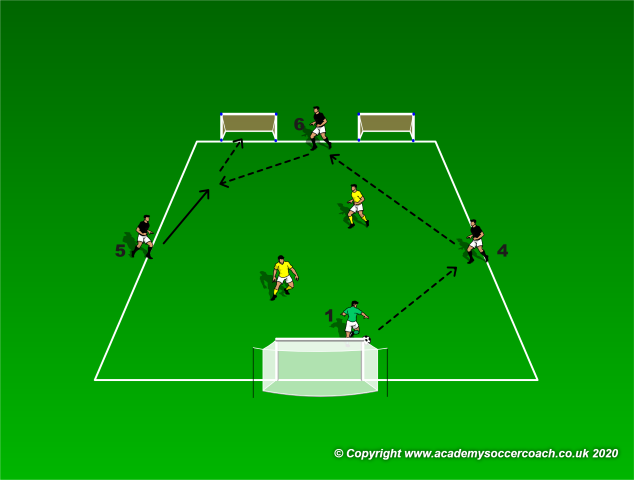
GK Distribution Under Pressure
By Philip Cauchi –
Title: Playing the ball with the feet under pressure
Aim: To be able to play accurate vertical passes when under pressure.
Key points:
1. Be light on the balls of the feet.
2. Oriented first touch.
3. Weight and direction of the kick (pass).
Practice: Receive the ball to score in the mini goals.
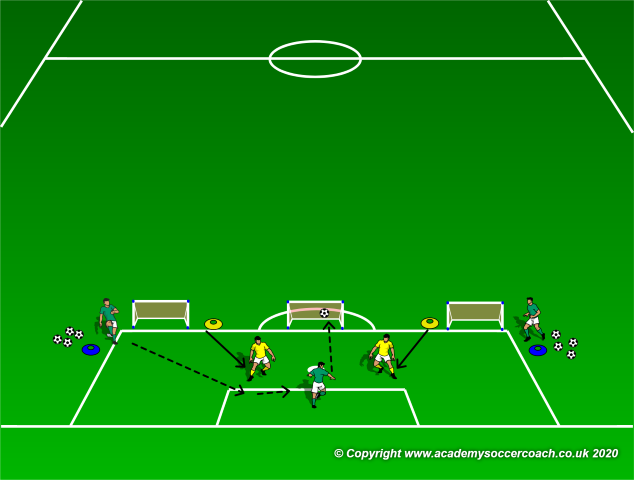
Preparation: A server – that can be the goalkeeper coach, a player recovering from an injury, or another goalkeeper – is positioned at each top corner of the penalty area with a supply of balls. Two other players act as opponents and start from the top of the penalty area as indicated in the above diagram.
Description: The servers take turns in passing the ball back to the goalkeeper who must quickly control the ball and kick it into any of the three mini goals. When a ball is passed to the goalkeeper by the servers the two defenders immediately apply pressure and aim to dispossess the goalkeeper and score in the regular goal.
Variations:
1. The servers may move to provide support in case the goalkeeper finds it very hard to kick the ball into any of the mini goals.
2. The servers play with the goalkeeper in securing possession of the balls until the moment to play forward into one of the mini goals is on. The area may need to be reduced in width for this variation (diagram below).
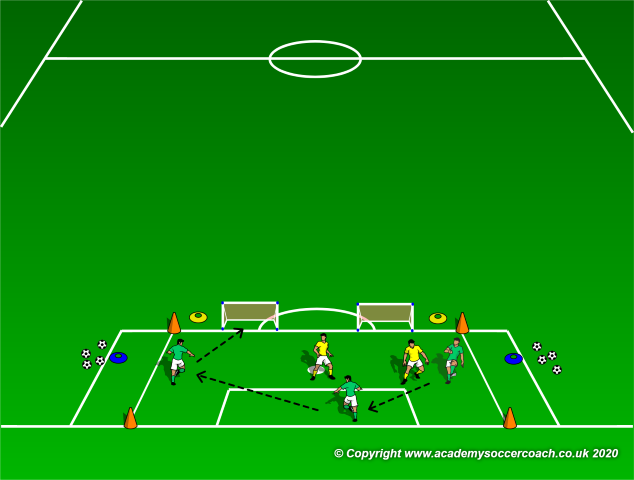
Progressions:
1. Reduce the area of practice so that the goalkeeper has less space and time to think.
2. Play the below small-sided situation where the goalkeeper together with his teammates have to play the ball forward into one of the mini goals simulating playing forward into midfield.

By Philip Cauchi
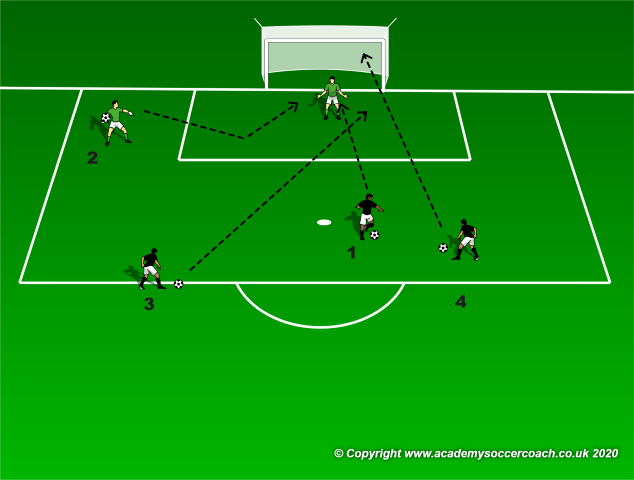
Saving Low Driven Shots Drills
By Philip Cauchi –
Title: Saving low driven shots drills
Aim: Save low driven shots aimed towards the corner of the goal.
Outcomes:
1. Start in the ready position with the hips slightly inclined forward.
2. Take a step forward before diving to make the save.
3. Lead into the dive with the toes of the foot on the side of the dive pointed diagonally towards the outside.
4. End up with the feet behind the line of the ball after making the save.
5. When on the ground rotate the legs inwards to use momentum to get up quickly into position after making the save.
Practice 1: The diving technique.
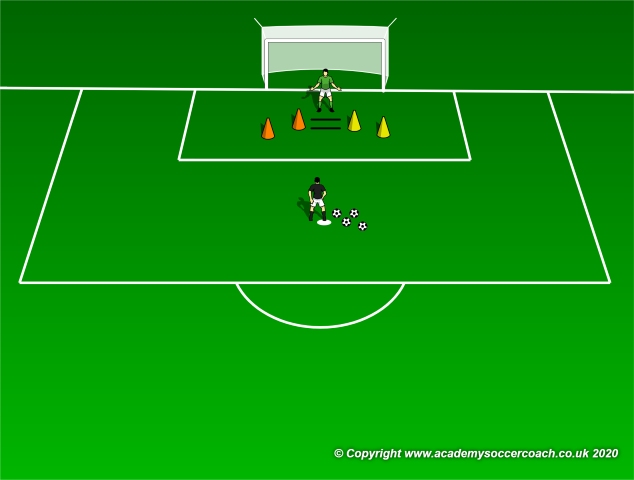
Preparation: The goalkeeper stands approximately two feet in front of the goal line in the ready position. A gate measuring a meter and a half in length is positioned to each side of the goalkeeper while two flat rubber lines are place in front of the goalkeeper and set approximately forty cm apart. The goalkeeper coach stands at a distance of eight yards in front of the goalkeeper.
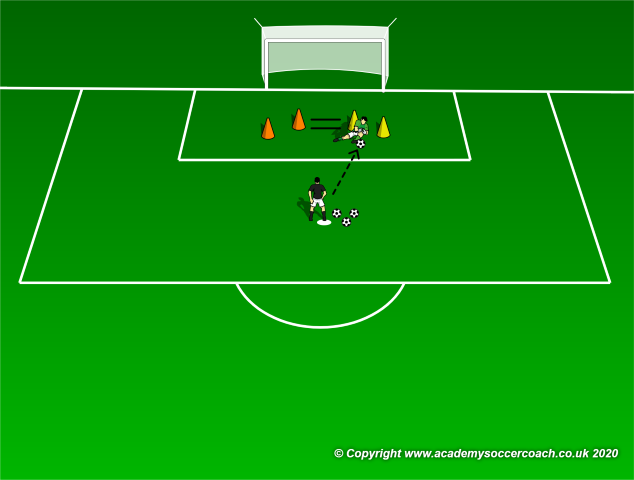
Description: The goalkeeper makes two quick forward steps prior to saving the low driven shot from the goalkeeper coach which is aimed to pass through the gates.
Variations:
1. Instead of making two quick forward steps the goalkeeper can make one or two forward jumps before diving to make the save.
2. The goalkeeper may or may not know to which gate (direction) the shot will be aimed.
3. Two shots are to be played in succession. After saving a shot, the goalkeeper has to get up quickly and make the next save. The goalkeeper may or may not know to which gate the two shots will be aimed.
Practice 2: FC Bayern München four shot practice.

This practice is taken from a Bayern Munich goalkeeping practice of which link is the following; https://www.youtube.com/watch?v=EqDGl0QEaO8.
Description:
1. Hi shot aimed at the goalkeeper from a close range that the goalkeeper has to securely catch.
2. Ball bounced once on the ground and the goalkeeper makes the save.
3. Low driven shot across the goal aimed at the left bottom corner of the goal (from the goalkeeper’s perspective).
4. Random shot at goal.
Practice 3: 3v1 to shoot.
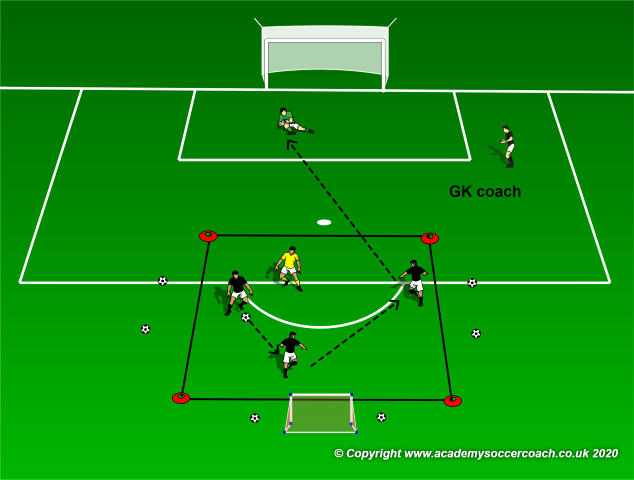
Preparation: An area measuring 10 yards by 10 yards is marked between twelve and sixteen yards from the goal. A goalkeeper is in goal while a defender and three attackers are placed inside this area.
Description: The three attackers aim to keep possession and after making three consecutive passes they can shoot on goal. The shots must be low driven (on the ground). The defender aims to win the ball and score in the mini goal positioned outside of the area. If the shot doesn’t take place after at least twenty seconds, the coach calls out “Shoot!” and the attacker with the ball takes a low driven shot at the goal defended by the goalkeeper.
Progression: After shooting at goal from the 3v1 situation, another ball is played to an attacker by the coach who has to finish with a first timer on goal.
By Philip Cauchi
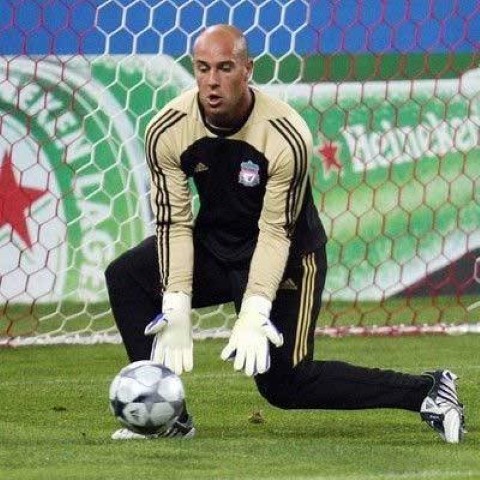
Saving Low Driven Shots
By Philip Cauchi –
Title: Saving low driven shots.
Aim: Use the scoop technique to save shots close to the body.
Outcomes:
1. Feet shoulder-width apart.
2. Stay behind the ball’s trajectory.
3. Eyes fixed on the ball.
4. Be light with the weight on the balls of the feet.
5. Arms and hands close with the palms together and opened towards the ball to scoop it up.
6. Rotate the body towards the ball.
7. Scoop the ball up without dropping the knee.
8. Clutch the ball to the chest and lean forward to secure it.

The scoop technique is used to save shots that are close to the body.
Practice 1: Catching low driven shots on different sides of the body.
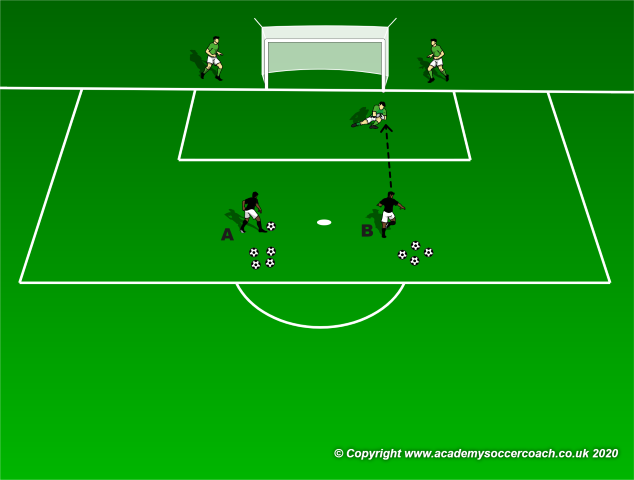
Preparation: Two servers A and B (who could be the goalkeeper coach, assistant coaches, and other goalkeepers waiting for their turn and even injured players) positioned in line with each corner of the goal and approximately ten yards away. Each server has a supply of balls.
Description: The two servers kick low driven shots for the goalkeeper to save. The shots must be aimed close to the goalkeeper. After making a save, the goalkeeper quickly gets up into the ready stance to make the next save from the other server. The goalkeeper makes six consecutive saves, alternating between the two servers and then rests for one and a half minutes to two minutes before taking on the next set of shots.
Progressions:
1. The servers get closer to each other and they figure out the order of the shots. Therefore, the goalkeeper will never know from whom the shot will arrive.
2. As in progression one but the waiting goalkeepers are positioned in front of the goalkeeper in goal to distract his/her vision.
Practice 2: Goalkeeper battle on two mini goals.
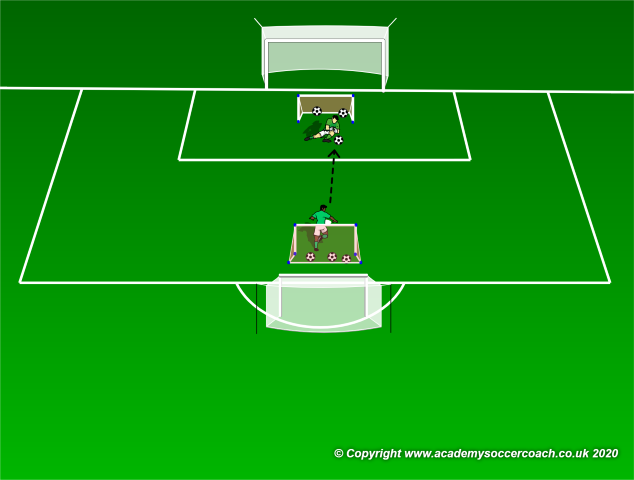
Preparation: Two mini goals are positioned ten yards apart and facing each other in front of regular goalposts so that the goalkeepers are orientated as they would normally be in a regular match. A number of balls are positioned in each mini goal.
Description: The goalkeepers kick the ball in an attempt to score in the opponent’s goal. They compete who of them can score the most goals in the mini goals in a pre-set amount of time.
Progression: The goalkeepers protect two mini goals positioned close to each other while trying to score on the opposite goal.
Practice 3: 2v2 + 1 + 2 target goalkeepers.
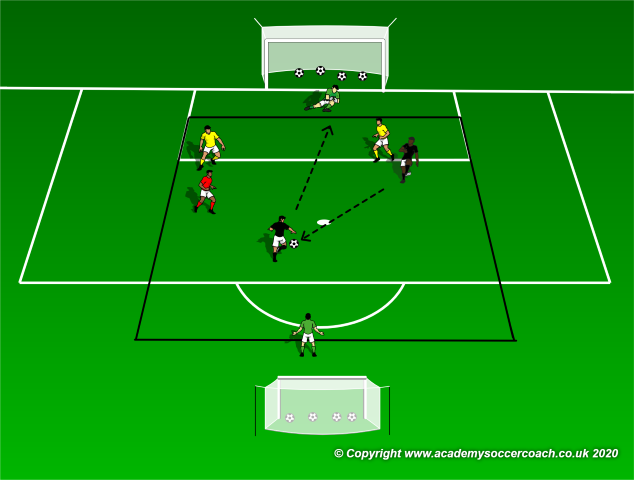
Preparation: Mark an area measuring 20 yards by 15 yards. Two teams each composed of a goalkeeper and two players plus a neutral player who plays for the team in possession take part. Teams have their goalkeeper positioned at their assigned end line.
Description: Both teams aim to score by passing the ball hard on the ground to the goalkeeper on the opposite line who must catch and protect it using the scoop technique. The goalkeepers also help their team to keep possession of the ball by passing it.
Progression: Make the area narrower (approximately 10 yards) and play a normal game (with shots on goal) where both teams are assigned to protect a goal and attack the opposite.
By Philip Cauchi
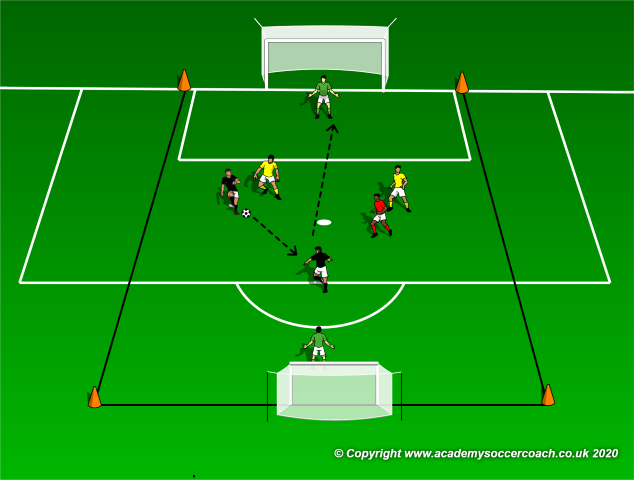
Closing Down the Shooting Angle
By Philip Cauchi –
Aim: Narrow down the opponent’s shooting angle.
Outcomes:
1. Feet shoulder width apart.
2. Toes pointed forwards.
3. Knees slightly bent.
4. Be light on the balls of feet.
5. Eyes focused on the ball.
6. Lean slightly forward.
Practice 1: Catching mid-level balls from three different shooting angles.
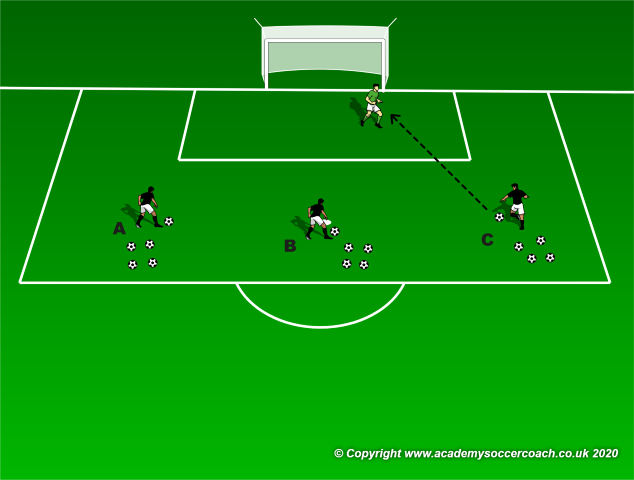
Preparation: Goalkeeper in goal and three other goalkeepers/servers (who can be coaches) positioned in the middle, to the left and to the right of the goal, ten meters away from the goal line. Each of the servers is supplied with a number of balls.
Description: The servers take their turns to kick mid-level balls straight at the goalkeeper who should quickly move to cover the angle.
Progressions:
1. The coach calls out which of the three serves kicks the ball.
2. The balls may be aimed at different heights and angles.
Practice 2: Quick get-ups to save mid-level shots.
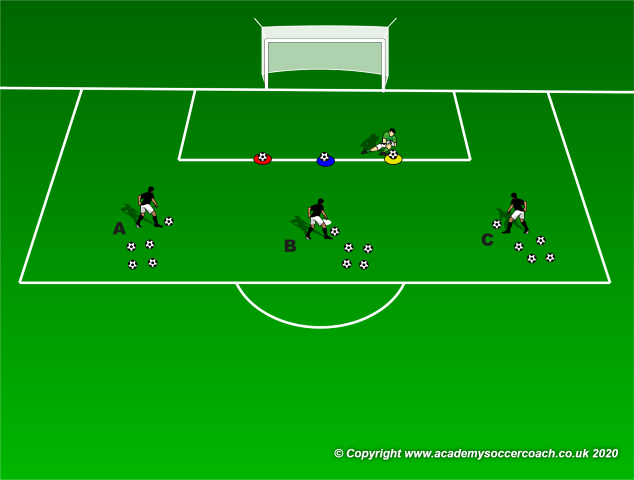
Preparation: As for practice 1 but now three markers each of a different color are positioned on the edge of the goal area. One of them in line with the middle of the goal, the other in line with the right corner of the goal, while the other is in line with the left corner of the goal. A ball is placed at each of these markers.
Description: The coach calls out a color which corresponds to the marker at which the goalkeeper dives to catch the ball as if making a save. The goalkeeper gets up on his feet to save the mid-level shot from the server that the coach calls.
Variation: Instead of calling out the color of the markers, the coach raises a marker that corresponds to the marker at which the goalkeeper dives to catch the ball.
Practice 3: GK+2 v GK+2 + 1 neutral on two regular goals.

Preparation: Mark an area measuring 20 yards by 15 yards. At each end line a regular goalpost is positioned. Two teams made of a goalkeeper and two outfield players compete with the aid of a neutral player who plays for the team in possession.
Description: Play always starts from the goalkeeper of the team in possession whenever the ball goes out of play or a goal is scored. It is important to play in short repetitions as this is a very intensive practice for the goalkeepers who must be continuously alert to make saves as well as play the ball with their feet. The goalkeepers are not allowed to score.
Progression: Play with two neutral players who are positioned at each side line. This should overload the goalkeeper more in terms of shots on goals.
By Philip Cauchi

How to Call For the Ball
By Mike Smith –
In almost every game, there are going to be those moments where the keeper and the defenders both have a play on the ball. While we all know the keeper can and should call off the defense, most of the time coaches just go with any outcome which doesn’t result in a goal as the appropriate play. We may just yell “Call it” to the keeper or “ Listen to your keeper” to the defense and hope for better next time. However, from a developmental standpoint ,i.e. practice, the keeper should call anything they are making a play on and the defenders should “back off” and allow the keeper to make the play, regardless if the keeper actually makes the play or not.
The idea here is certainty. Certainty is a strength and will create definite, predictable outcomes. Uncertainty creates confusion and unpredictable outcomes. So while we will all take anything which doesn’t allow a goal in a game, the best course of action in practice is to steer your keeper and defensive unit towards the certain outcome – if the keeper calls it, the keeper gets it.
Set Up
This drill is best done with at least 2 keepers, if your squad only has one dedicated keeper, insert your back up keeper for this activity. In the face of goal, ( shown below ) two keepers wait for a service from the top of the 18. When the ball is served, the first keeper to call it ( by yelling KEEP! or KEEPER! ) makes the save. Another ball is served immediately – presumably for the second keeper to call and save. IF, the keeper who saves the first ball can make the save and call the second ball as well, they will get a chance at two saves. Play is reset after every two services. The keepers cannot call for the second save until after the first service is saved. The server ( preferably an additional keeper or coach ) should make sure at the start of the drill the second service is hit before the first one can be saved. This gives the keepers equal time to warm up and get the feel of the drill. As the drill progresses, the server can take some time between the first and second service and create some friendly competition between the two keepers. Balls should be served in a variety of ways – from the ground to a lob with the only condition being all balls are served on frame.
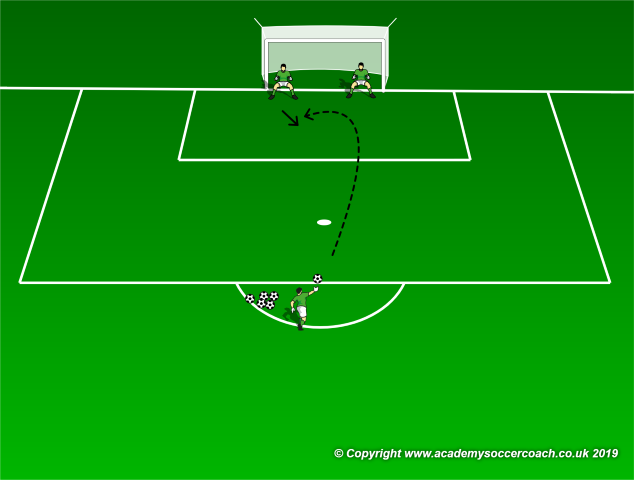
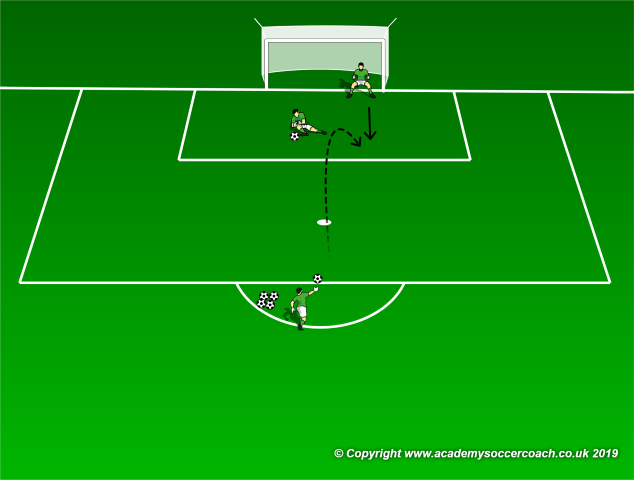
Coaching Point
It is important the keeper actually yell KEEP or KEEPER as opposed to MINE or I GOT IT. Ideally all players are letting each other know when they are making a play on a contested ball and MINE or I GOT IT does not definitely mean KEEPER, especially in the heat of the moment. Again, be certain – make sure the keeper is saying KEEP.
Progression 1
Once the keepers have gotten the hang of calling for the ball, bring in 4 to 6 defenders. Start them one at a time running in from the post. The services now may be anywhere inside the box. One defender at a time comes out for each service. If the keeper calls for it, the defender retreats back towards the goal mouth – ( where the next play will be if the keeper misses the ball ) . If the keeper does not call for it, the defender settles and passes it back to the server. Progress this to where two defenders ( one from each post ) come out each time.
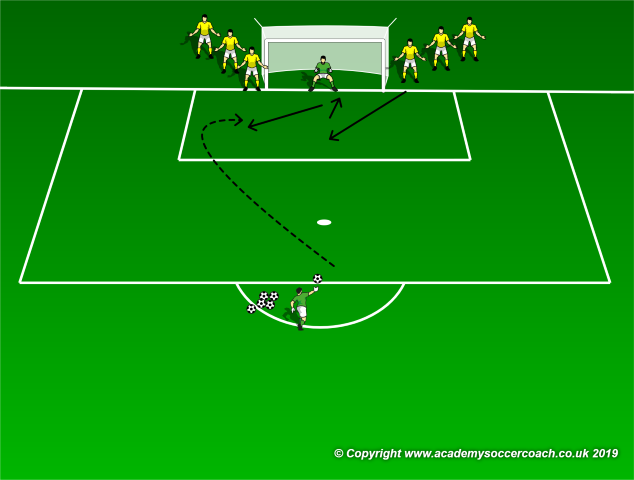
Progression 2
Now add 4 to 6 attackers as well, coming in groups of two. The action here should be continuous after the first ball is served. To start, the keeper sends a ball out to the attackers who are waiting 30 to 40 yds out. When the attacker settles the ball, 4 defenders come out, two off each post. The attacking group has 3 seconds to serve / shoot the ball in – thus the receiving attacker will most likely serve it and the second attacker will crash in to attempt a finish. There is a supply of balls waiting with the other attackers. IF the defense or keeper wins the ball clean, they send it immediately out to the next two attackers. If a shot is missed or the ball is cleared out, the next two attackers take a ball and attack, following the 3 second guideline. Here is the trick – the defenders MUST get back to the post before coming back in and MUST interchange 2 players each time. This will create a lot of movement and chaos in front of the goal, all while a ball is being served in, and is the perfect condition for the keeper to practice creating CERTAINTY by calling the ball and having the defenders step back and cover goal.
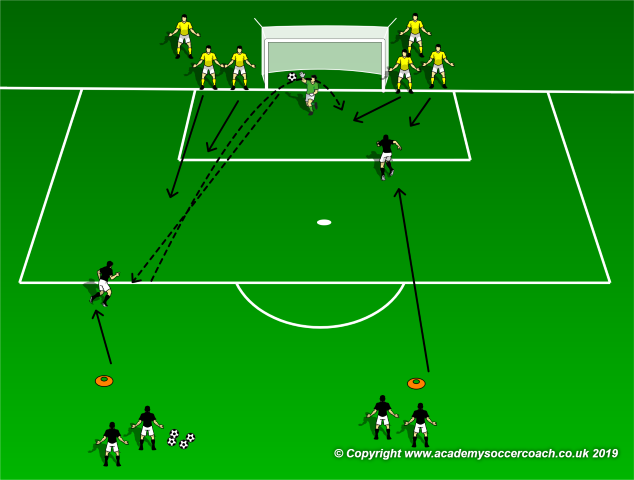
Coaching Points
Progression 2 can be adjusted to create the desired effect – which is balls coming in with several defenders and the keeper attempting to come in quickly and play it. The coach should focus entirely on the communication and corresponding movement between the keepers and the defenders. IF the keeper calls is, defenders step back and cover, keeper makes the play. IF the keeper holds their position in the net, defenders make the play.
By Mike Smith
Currently the Head Coach for University Heights Academy Boys Soccer in Hopkinsville, KY , Mike is in his 14th year as a high school head coach with 23 years coaching experience overall and 34 year as a student and fan of the game. He holds a USSF D License.
